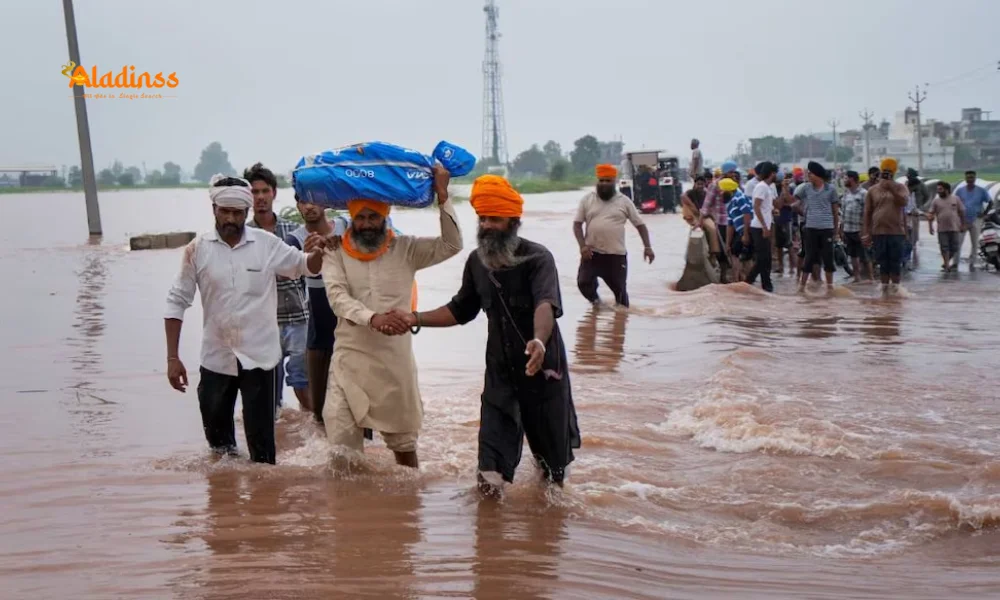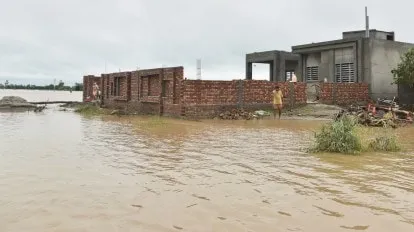Punjab Floods 2025: All 23 Districts Hit, 3.5 Lakh Affected

Punjab Declares All 23 Districts Flood-Hit: 3.5 Lakh Affected
On September 2, 2025, the Punjab government declared all 23 districts as flood-hit, reporting that the devastating floods have claimed 30 lives and impacted over 3.5 lakh people across 1,400 villages. The deluge, described as the worst in nearly four decades, has caused extensive damage to crops, submerging 1,48,590 hectares of farmland, particularly in districts like Gurdaspur, Mansa, and Amritsar. With rivers like the Sutlej, Beas, and Ravi flowing near danger levels and dam reservoirs at full capacity, the state has intensified rescue and relief operations to mitigate the crisis.

Widespread Devastation Across Punjab
The floods, triggered by heavy monsoon rains in the upper catchment areas of Himachal Pradesh and Jammu & Kashmir, have wreaked havoc across Punjab. The state’s major rivers—Sutlej, Beas, and Ravi—along with seasonal rivulets, have overflowed, inundating villages, farmlands, and urban areas. According to Cabinet Minister Hardeep Singh Mundian, the disaster has now spread to all 23 districts, up from an initial 12, affecting 3,54,626 people and submerging 1,400 villages. Gurdaspur remains the worst-hit, with 324 villages impacted, followed by Amritsar (135 villages) and Hoshiarpur (119 villages).
The agricultural sector, a cornerstone of Punjab’s economy, has suffered significant losses, with 1,48,590 hectares of standing crops, primarily paddy, destroyed. Districts such as Mansa (42,020 acres), Amritsar (56,834 acres), and Kapurthala (36,902 acres) have reported extensive damage, threatening food security and farmers’ livelihoods. The government has ordered a special ‘girdawari’ (crop loss assessment) to evaluate the damage once floodwaters recede, but prolonged waterlogging poses a severe risk to the ongoing harvest season.
Rescue and Relief Operations in Full Swing
The Punjab government, in coordination with multiple agencies, has launched extensive rescue and relief operations. Nearly 20,000 people have been evacuated from flood-hit areas, with 174 relief camps established, 74 of which are currently active. The National Disaster Response Force (NDRF) has deployed 23 teams across districts, with six teams each in Gurdaspur and Amritsar, and three each in Ferozepur and Fazilka. The Indian Army, Air Force, and Navy have mobilized 12 columns, including two engineer columns, and around 35 helicopters to assist in rescue efforts.
The Border Security Force (BSF) and State Disaster Response Force (SDRF) are providing ground support, particularly in border districts like Gurdaspur and Ferozepur. Additionally, 114 boats and one state helicopter are being used to evacuate stranded residents and distribute relief materials, including food, water, and medical supplies. Drones are also being deployed to deliver essentials like milk powder and dry rations to remote areas, such as Ajnala in Amritsar, where floodwaters have cut off access.
Also Read: Gold Price Hits Record High in India 2025
Government Response and Leadership Visits
Chief Minister Bhagwant Mann and Governor Gulab Chand Kataria have actively engaged with the crisis, visiting affected areas to assess the situation and boost morale. Mann toured flood-hit Ferozepur by boat, interacting with residents and overseeing relief efforts. Kataria visited Ferozepur and Tarn Taran, two of the hardest-hit districts, to review rescue operations and meet with affected communities. Their presence underscores the state’s commitment to addressing the crisis on a war footing.
Mann has also appealed to the Central Government for immediate financial assistance, requesting the release of ₹60,000 crore in pending state funds. Expressing concern over the “meagre compensation” provided under the State Disaster Response Fund (SDRF), he urged the Centre to revise relief norms, proposing a minimum of ₹50,000 per acre for crop loss compared to the current ₹15,000 per acre (including state contributions). Mann emphasized that Punjab is demanding its rightful share, not charity, to support flood-affected residents.
Addressing Farmers’ Concerns
Governor Kataria echoed the demands of local farmers for permanent ownership rights to their land, which would enable them to access crop loss compensation and government schemes. Many farmers in flood-prone areas lack clear land titles, limiting their eligibility for financial aid. Kataria assured residents that he would raise the issue with Chief Minister Mann to seek a permanent resolution, highlighting the need for systemic reforms to protect vulnerable agricultural communities.
The floods have exacerbated existing challenges for Punjab’s farmers, who rely heavily on the paddy crop for their livelihoods. The destruction of 1,48,590 hectares of farmland, particularly in the crucial harvest season, threatens to deepen financial distress. The state has committed to conducting a comprehensive damage assessment once the floodwaters recede, with preliminary estimates indicating losses in the billions of rupees.
Health and Infrastructure Support
Health Minister Balbir Singh announced the deployment of 818 medical teams across flood-affected areas to provide critical care and prevent disease outbreaks. “Our goal is to ensure that no person is left without medical care,” Singh stated, emphasizing the risk of waterborne diseases like cholera and skin infections due to prolonged exposure to floodwaters. Medical camps have been set up in relief shelters, offering free consultations, medicines, and vaccinations to affected residents.
The floods have also damaged infrastructure, including roads, schools, and homes, with over 300 schools reporting waterlogging and structural damage. The Punjab Education Department has extended school closures until September 3, 2025, to ensure student safety and allow for repairs. Urban areas like Jalandhar and Patiala have faced severe waterlogging, disrupting daily life and industrial activities, with power outages reported due to flooded substations.
Challenges and Future Preparedness
The overflow of dams like Bhakra, Pong, and Ranjit Sagar, coupled with breaches in embankments, has worsened the flooding. The Bhakra Beas Management Board (BBMB) released 1.09 lakh cusecs of water from the Pong Dam, exceeding its capacity, while the Ranjit Sagar Dam recorded high inflows. These releases, combined with sustained rainfall, have overwhelmed flood control systems, highlighting the need for improved infrastructure and water management strategies.
Experts and local leaders have called for long-term solutions, including desilting rivers, strengthening embankments, and coordinating water releases with neighboring states. The unprecedented scale of the 2025 floods, compared to the 1988 disaster, underscores the urgent need for climate-resilient infrastructure to protect Punjab’s agrarian economy and vulnerable communities.
Comment / Reply From
No comments yet. Be the first to comment!











